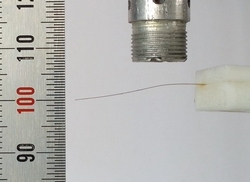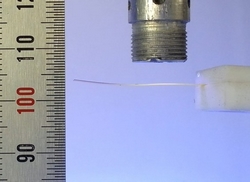Molecule deformation to macroactuation: In a novel hybrid assembly photoisomerization causes microscale deformation of molecules that is amplified to macroscale bending of a composite membrane. The nanoscale molecular crystals, which are unevenly distributed in a functional polymer matrix, provide a new strategy for designing higher performance actuators that combine the advantages of both molecular crystals and liquid crystal elastomers.
Recently, Prof. CHEN Wei’s research group from Suzhou Institute of Nano-Tech & Nano-bionics, Chinese Academy of Sciences(SINANO), report the development of a hybrid nanoscale organic molecular crystal assembly as a photoresponsive actuator.
In this novel system, rod-like nanocrystals of 2-hydroxynaphthylidene-1′-naphthylamine (HNAN) are selectively oriented and unevenly distributed in a compact polyvinylidene fluoride–hexafluoropropylene (PVDF–HFP) copolymer membrane. Compared with pure PVDF–HFP, which does not show any response to UV light, the composite membrane presents UV-induced bending, even with only 1 wt % of HNAN. Such an assembly approach would be a practicable way to combines the advantages of both LCEs and molecular crystals for actuator design.
This work has been published in Angewandte Chemie International Edition (DOI: 10.1002/anie.201300856).This research was supported by the National Natural Science Foundation of China and the Natural Science Foundation of Jiangsu Province.


Fig. 1 Nanocomposite membrane before illuminated (left) and after illuminated (right)(Image by SINANO)

Fig 2. a) Gradient distribution and selective orientation of nanocrystals in nanocomposite membrane section b) Photo-mechanical response curve(Image by SINANO)

